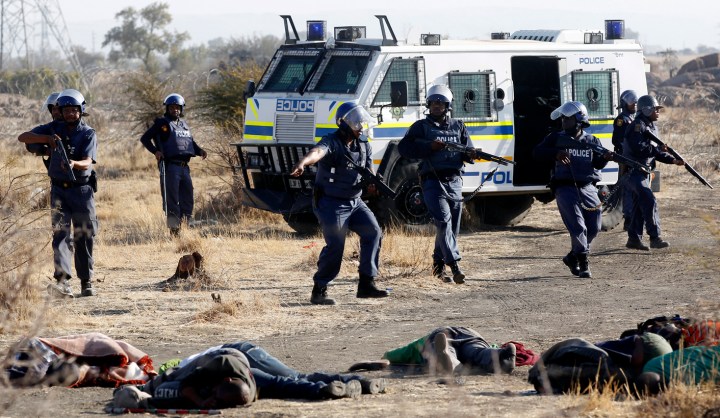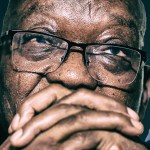South Africa
Farlam Commission: More Marikana massacre secrets and lies

Major General Ganasen Naidoo, a deputy commissioner in the North West Province, was the highest-ranking officer to fire his weapon during the Marikana massacre. His cross-examination at the Farlam Commission is unearthing some disturbing facts and untruths, writes GREG MARINOVICH.
On the afternoon of Monday 13 August 2012, Naidoo was in the backseat of his boss’ official car. He and the boss, Lieutenant General Zukiswa Mbombo, were on the way from a meeting at Marikana to their headquarters at Potchefstroom.
Mbombo had tasked her other deputy commissioner, William Mpembe, to disarm miners who had gone to intimidate some of their fellow Lonmin workers who had failed to join the strike. Naidoo remembers that Mbombo was sitting up front alongside her driver, and that she received several calls, some of them in ‘vernacular’, as he puts it. She was also chatting to her driver.
It would seem that Naidoo was not paying much attention to his superior’s conversations, mostly as he could not understand. In fact, he told the Commission that Mbombo would often begin speaking to him in the ‘vernacular’, and he would have to stop her, reminding her of his linguistic deficiencies.
What Naidoo claims to have missed is a call to Mbombo from General Mpembe, informing her that he was going to deviate from her orders: that instead of disarming the miners, he would escort them to their koppie stronghold at Nkaneng. There is police footage from the scene showing him on the phone.
Oddly, Mbombo herself claimed she never received such a call from Mpembe.
So, the scene is set: the province’s highest-ranking cop saying that her deputy was lying in his testimony. Naidoo supported his boss’ version – he was unaware of any such call; but then, perhaps it was in the ‘vernacular’. He also says Mbombo did not share that information with him.
The next call from Mpembe – if there had been a previous one – elicited a more direct response. The car bearing the generals away from Marikana turned around and sped back. This call from Mpembe was to say that two cops had been killed in a confrontation with the miners.
This is a key part of the Marikana puzzle. There was either an innocent breakdown in communication between the tops cops overseeing Marikana, or their various attempts to spin their way out of trouble were knocking heads.
The death of the policemen on the Monday, as well as of the three miners killed in the same incident (two by police) laid the stage for the massacre that was to happen three days later, on 16 August.
On that day, the fateful Thursday, Naidoo was given two tasks: he had to escort paramedics to any scene where they were needed, should people be injured; and he had to use the reserve forces with him to sweep the veld and koppies as part of the ‘tactical’ option, should the miners refuse to co-operate.
The account of Naidoo’s day has come under intense scrutiny at the Commission. There are major discrepancies between what he is said to have done, and the reasons or rationale for his actions.
The Commission’s Advocate Matthew Chaskalson has gone through the various stills and video footage, car tracking devices and testimonies to query Naidoo’s behaviour on the day.
Naidoo’s main task, by his admission, was to escort medics, if necessary; yet despite hearing about shooting at Scene One at the kraal below the koppie, he and his driver managed to take a long, snaking convoy of police vehicles (with paramedics) away from the wounded.
He then stopped the convoy, took a few vehicles with K9 unit policemen and their dogs, and headed for what was to become Scene Two, the killing koppie where Daily Maverick exposed the murders of 18 more miners.
It is in this part of the lengthy cross-examination that Naidoo seems to keep avoiding a straight answer. If the general’s primary task, as he admits, was to take medics to the injured people at Scene One, why did he instead get involved in a tactical offence at Scene Two?
The General – an intelligent man who has a doctorate, and lots of on-the-ground experience in South Africa’s historical conflicts – tries to confuse the issue of what he did or did not know about there being injured or dead people at Scene One. There is talk of a partial failure of the radios, of poor communication, of not being able to get through to other officers on his cell phone.
Yet Chaskalson has a list of the exact calls and phone texts between all the main players. It seems inconceivable that he did not know of what had happened in the first part of the massacre. Yet of course this is what he needs to stick to, or else how can he justify not taking medics to the scene?
Paramedics only got to Scene One an hour after the shooting. In that time, veteran human rights advocate Dumisa Ntsebeza claims that at least one victim of the police shooting bled to death unnecessarily. There were perhaps more who could have been saved by timeous medical intervention.
Naidoo claims to have been lost – even though his driver was a colonel from the local Marikana police station – and that shooting in the vicinity prevented him from escorting the medics.
Logic dictates that he should have called for an armoured vehicle to take the medics in, or called the command centre to ask people at Scene One if it was okay for him to proceed with a soft-skinned vehicle. He could even have called officers at Scene One directly (he says he tried but it failed, a claim disputed by the evidence leaders).
For whatever reason, quite suddenly, it would seem, Naidoo switched from the task of facilitating urgent medical care to that of hunting down fleeing miners in the veld and boulders.
Naidoo claims that it is a policeman’s duty to assist other cops in a perilous situation. He took his small team of men and dogs and joined up with a sweep line of National Intervention Unit (NIU) cops making their way towards Scene Two.
It was at this time that Naidoo saw a man fleeing with a long barrelled weapon he took to be, possibly, the R5 assault rifle stolen from police in the deadly clash three days previously. Yet despite the police shooting, arresting or searching every person leaving the koppie, no sign of a rifle was ever found. Even days of searching the crevices and boulders afterwards failed to reveal it.
Naidoo says that while he approached the koppie, he came across two dead miners – Anele Mdizeni (body A) and Thabiso Thelejane (body B) who were shot down while charging at police, according to what the NIU members told him. The miners had allegedly charged at police with hand weapons.
The trouble here is that the video evidence shows that not a single policeman was closer than 45 metres to the miners when they were killed. It is difficult to argue self-defence in the case of two men with spears and knobkieries posing a threat to trained cops with assault rifles at least two cricket pitch lengths away.
From the base of that large boulder where the two men were killed, Naidoo, his K9 unit and some NIU moved up and were about to crest the boulder, which is about five metres high, when Naidoo claims he saw a miner shooting at him from bushes to his left. He says the bullet hit the rock near his feet. He returned fire, but was unable to discern whether he hit a target.
Here, again, Naidoo’s version of events has been picked apart in cross-examination, and by several statements from his own dog handlers and that of other units. The General’s version stands in contrast to that of Public Order Policing member Warrant Officer Mamabolo, who says that when he arrived on the scene, his repeated calls for the police on the rocks above them – including Naidoo – to cease shooting were ignored.
The nuance of what happened is critically important, as it points to the state of mind, and the intentions of the highest-ranking officer in the field during the massacre.
Warrant Officer Mamabola testified that “once the shooting of live ammunition stopped, I observed some of the protesters coming out of the bushes behind the boulders/rocks with their raised hands. Suddenly I saw one of the protesters falling to the ground.”
This fits in with the Daily Maverick’s stories from 2012 (see here for a miner’s experience of what happened). Naidoo’s statements – there are various written affidavits to most of the policemen’s testimonies – fail to mention such key moments.
Crucial was one of Naidoo’s initial K9 group of cops – Warrant Officer Hendrick Myburgh – who says he witnessed another policemen acknowledge murdering a wounded miner. Naidoo says he was unaware of this.
The Commission heard from miners’ testimonies how their comrades were shot and killed when they tried to surrender to the police. Naidoo had no knowledge of this, despite having taken command of the policemen at the Scene Two koppie, he said.
Naidoo was also unaware of another of his K9 unit, Warrant Officer Lukas Breedt, planting weapons among the dead for the crime scene picture.
The Commission has also been told how the police gathered for nine days to plan for the Commission – and glaring inconsistencies, not to say outright untruths, have emerged from that version of the events at Marikana.
General Naidoo’s time under cross-examination is not yet complete, and the dance around truth and culpability continues. But so far, as a very high-ranking officer entrusted with protecting the lives and rights of South Africa citizens, he has not acquitted himself very well. DM
Photo: A policeman gestures in front of some of the dead miners after they were shot outside Marikana, August 16, 2012. REUTERS/Siphiwe Sibeko















 Become an Insider
Become an Insider